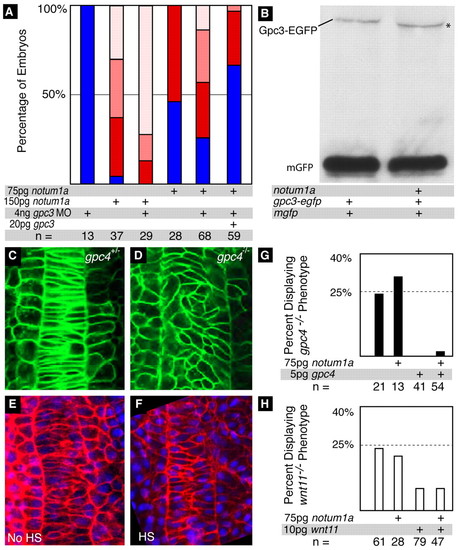
Notum 1a interacts with specific glypicans. (A) Inhibition of posterior body in notum1a-overexpressing embryos is enhanced by depletion of gpc3. Although co-injection of gpc3 MO increases the number of embryos with severe inhibition of posterior body (P=0.003), co-injection of gpc3 mRNA reduces the number of embryos displaying any posterior body impairment compared with notum1a-injected (P=0.05) and notum1a mRNA- and gpc3 MO-injected (P=0.002) embryos. The phenotypic classes are the same as depicted in Fig. 2A. (B) Notum 1a overexpression produces a faster migrating form of Gpc3-EGFP. A western blot of lysates from mGFP/gpc3-EGFP-injected and mGFP/gpc3-EGFP/notum1a-injected embryos probed with an anti-GFP antibody reveals that the gpc3-EGFP band migrates faster in lysates from notum1a-injected embryos. (C-F) Notum 1a overexpression does not mimic the Gpc4 loss-of-function phenotype. (C,D) Confocal images of the notochords of gpc4fr6/+ (C) and gpc4fr6/fr6 (D) Tg(Bactin:HRAS-EGFP)vu119 embryos at five somites. Although the cells of the notochords of gpc4fr6/+ embryos display normal mediolateral elongation and orientation, the cells are disorganized in the homozygous mutants. (E,F). Confocal images of three somite embryos injected with mCherry-HsHRAS RNA non-heat shocked and Tg(hs:notum1a) embryos heat shocked at 50% epiboly. Both control (E) and notum1a-overexpressing (F) embryos display normal cell elongation and orientation. (G) notum1a does not interact with Gpc4 or Wnt11. An incross of gpc4fr6/+ results in a Mendelian ratio of embryos displaying a mutant phenotype at 24 hpf. Injection of gpc4 mRNA efficiently rescues this phenotype. Co-injection of notum1a with gpc4 mRNA does not impair the rescue of the mutant phenotype (P=0.565). (H) Similarly, wnt11tz216/+ fish were incrossed to produce a Mendelian ratio of mutant embryos displaying some degree of cyclopia. This phenotype can be suppressed by injection of wnt11 mRNA, and co-injection of notum1a did not inhibit this effect (P=0.95).
|

